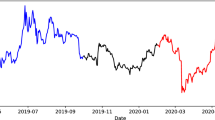Abstract
The paper develops a class of continuous timestochastic volatility models, which generate asset price returnsthat are approximately Student t distributed. Using thecriterion of local risk minimisation in an incomplete marketsetting, option prices are computed. It is shown that impliedvolatility smile and skew patterns of the type often observed inthe markets can be obtained from this class of stochasticvolatility models.
Similar content being viewed by others
References
Black, F. and Scholes, M. (1973) The pricing of options and corporate liabilities, J. Polit. Economy 81, 637-659.
Bollerslev, T. (1986) Generalized autoregressive conditional heteroskedasticity, J. Econometrics 31, 307-327.
Bollerslev, T., Chou, R., and Kroner, K. (1992) ARCH modelling in finance: A review of the theory and empirical evidence, J. Econometrics 52, 5-59.
Chesney, M. and Scott, L. (1989) Pricing European currency options: A comparison of the modified Black-Scholes model and a random variance model, J. Financ. Quantitat. Anal. 24, 267-284.
Clewlow, L. and Xu, X. (1992) A review of option pricing with stochastic volatility, University of Warwick, preprint FORC 92/35.
Clewlow, L. and Xu, X. (1994) The dynamics of stochastic volatility, FORC Preprint 94/53, Financial Options Research Centre, University of Warwick.
Cox, J. C. and Ross, S. A. (1976) The valuation of options for alternative stochastic processes, J. Financ. Econom. 3, 145-166.
Derman, E. and Kani, I. (1994) Riding on a smile, Risk 7, 32-39.
Dupire, B. (1994) Pricing with a smile, Risk 7, 18-20.
Engle, R. F. and Ng, V. K. (1993) Measuring and testing the impact of news on volatility, J. Finance 48, 1749-1801.
Föllmer, H. and Schweizer, M. (1991) Hedging of contingent claims under incomplete information. In M. Davis and R. Elliott (eds), Applied Stochastic Analysis, Volume 5 of Stochastics Monogr., Gordon and Breach, London/New York, pp. 389-414.
Föllmer, H. and Sondermann, D. (1986) Hedging of non-redundant contingent claims. In W. Hildebrandt and A. Mas-Colell (eds), Contributions to Mathematical Economics, North Holland, pp. 205-223.
Frey, R. (1997) Derivative asset analysis in models with level-dependent and stochastic volatility. Mathematics of Finance, Part II, CWI Quarterly 10(1), 1-34.
Ghysels, E., Harvey, A., and Renault, E. (1996) Stochastic volatility. In Statistical Methods in Finance, Volume 14 of Handbook of Statist., North Holland, pp. 119-191.
Harrison, J. M. Pliska, S. R. (1981) Martingales and stochastic integrals in the theory of continuous trading, Stochastic Process. Appl. 11, 215-260.
Heath, D., Platen, E., and Schweizer, M. (1998) A comparison of two quadratic approaches to hedging in incomplete markets. University of Technology Sydney (working paper), to appear in Math. Finance.
Heston, S. L. (1993) A closed-form solution for options with stochastic volatility with applications to bond and currency options, Rev. Financ. Stud. 6(2), 327-343.
Hofmann, N., Platen, E., and Schweizer, M. (1992) Option pricing under incompleteness and stochastic volatility, Math. Finance 2(3), 153-187.
Hull, J. and White, A. (1987) The pricing of options on assets with stochastic volatilities, J. Finance 42, 281-300.
Hull, J. and White, A. (1988) The use of control variate techniques in option pricing, J. Financ. Quantitat. Anal. 23(3), 237-251.
Hull, J. C. (1993) Options, Futures, and Other Derivative Securities, Prentice-Hall International, Inc.
Hurst, S. R. and Platen, E. (1997) The marginal distributions of returns and volatility. In Y. Dodge (ed.), L 1 -Statistical Procedures and Related Topics, Volume 31 of IMS Lecture Notes-Monograph Series, Institute of Mathematical Statistics Hayward, California, pp. 301-314.
Hurst, S. R., Platen, E., and Rachev, S. T. (1997) Subordinated market index models: A comparison, Financ. Engng Japanese Markets 4, 97-124.
Ikeda, N. and Watanabe, S. (1989) Stochastic Differential Equations and Diffusion Processes (2nd edn), North-Holland (1st edn (1981)).
Jackwerth, J. C. and Rubinstein, M. (1995) Recovering probability distributions from contemporaneous security prices, Working Paper, Haas School of Business, University of California at Berkeley.
Johnson, H. and Shanno, D. (1987) Option pricing when the variance is changing, J. Financ. Quantitat. Anal. 22, 143-151.
Kloeden, P. E. and Platen, E. (1999) Numerical Solution of Stochastic Differential Equations, Appl. Math. 23, Springer (3rd corrected printing).
Melino, A. and Turnbull, S. (1990) Pricing foreign currency options with stochastic volatility, J. Econometrics 45, 239-265.
Nelson, D. B. (1990) ARCH models as diffusion approximations, J. Econometrics 45, 7-38.
Platen, E. (1997) A non-linear stochastic volatility model, Technical Report, Australian National University, Canberra, Financial Mathematics Research Reports, FMRR 005-97.
Platen, E. (1999) On the log-return distribution of index benchmarked share prices, Technical Report, University of Technology, Sydney, QFRG Research Paper 22.
Platen, E. and Schweizer, M. (1998) On feedback effects from hedging derivatives, Math. Finance 8(1), 67-84.
Rubinstein, M. (1985) Nonparametric tests of alternative option pricing models using all reported trades and quotes on the 30 most active CBOE option classes from August 23, 1976 through August 31, 1978, J. Finance 11, 455-480.
Rubinstein, M. (1994) Implied binomial trees, J. Finance 49, 771-818.
Schweizer, M. (1991) Option hedging for semimartingales, Stochastic Process. Appl. 37, 339-363.
Scott, L. O. (1987) Option pricing when the variance changes randomly: Theory, estimation and an application, J. Financ. Quantitat. Anal. 22, 419-438.
Stein, E. M. and Stein, J. C. (1991) Stock price distributions with stochastic volatility: An analytic approach, Rev. Financ. Stud. 4, 727-752.
Taylor, S. J. and Xu, X. (1993) The magnitude of implied volatility smiles: Theory and empirical evidence for exchange rates, FORC preprint 93/40, University of Warwick.
Wiggins, J. B. (1987) Option values under stochastic volatility. Theory and empirical estimates, J. Financ. Econom. 19, 351-372.
Author information
Authors and Affiliations
Rights and permissions
About this article
Cite this article
Heath, D., Hurst, S. & Platen, E. Modelling the Stochastic Dynamics of Volatility for Equity Indices. Asia-Pacific Financial Markets 8, 179–195 (2001). https://doi.org/10.1023/A:1016216432647
Issue Date:
DOI: https://doi.org/10.1023/A:1016216432647




